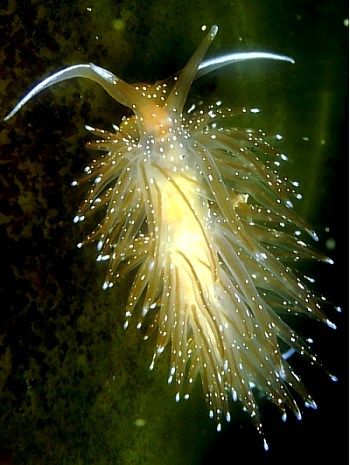
Sakuraeolis enosimensis
(Baba, 1930)
Order: NUDIBRANCHIA
Suborder: AEOLIDINA
Family: Glaucidae
DISTRIBUTION
Japan, Hong Kong. Introduced to San Francisco, California.
PHOTO
12m, Ninepin Group, Hong Kong. 21 January 2001. Photo: Leslie Chan.
Most skin tinged with translucent orange brown. Depending on the colour of the underlying organs the colour of different parts of the body can vary from an orange to a cream yellow. There is a white tip to the smooth tapered rhinophores and a white line alomf the dorsal side of the long tapering oral tentacles. There is also a dorsal white line along the tip of the posterior foot. One of the most characteristic features of the species are the brilliant opaque white spots and specks scattered over the head and cerata. Grows to 30mm or more.
Authorship detailsRudman, W.B., 2001 (July 10) Sakuraeolis enosimensis (Baba, 1930). [In] Sea Slug Forum. Australian Museum, Sydney. Available from http://www.seaslugforum.net/find/sakuenos
Related messages
Re: Sakuraeolis enosimensis - with parasite?
May 4, 2006
From: Song Xikun
Concerning message #16496:
Dear Rie Nakano
Dear Bill,
At present I have more than 100 adult S. enosimensis temporarily cultured in laboratory for my MS thesis, and of course, I have also noticed the swellings on the right side of them.
By the way, I find the spawning behavior of this nudibranch interesting, especially the shape of the egg ribbon. Based on field and laboratory observations, this aeolid has two types of egg mass. One type is around its hydrozoan prey, while the other is spawned into discal rings on flat substratum, e.g. the Ulva sp. or artificial plates. Similar egg mass spawning is also found in the nudibranch Flabellina rubrolineata in my laboratory. However, F. rubrolineata does not have these swellings. Thus the egg mass dimorphism might be not affected by the swellings. Anyway, you two have give me a good advice to understand the egg mass dimorphism from the viewpoint of swellings. I think, maybe, I can conduct histology studies of the nidamental glands as well as the swellings.
If you have other ideas about the swelling and the egg mass dimorphism, please tell me quickly, because the availability of this nudibranch in the field here is very short, after all, I have missed more than 1 years of this beauty.
Song Xikun
xksong@xmu.edu.cn
Song, X.K., 2006 (May 4) Re: Sakuraeolis enosimensis - with parasite?. [Message in] Sea Slug Forum. Australian Museum, Sydney. Available from http://www.seaslugforum.net/find/16521Dear Song,
Thanks for your message. I think the dimorphism in the shape of the egg ribbon you describe is more a function of where the ribbon is being attached rather than two different morphological types or egg laying behaviours. Nudibranchs usually lay a spiral egg ribbon, but when they can't lay it on a flat surface they do the best they can - which sometimes looks quite strange - and sometimes means wrapping the ribbon around a thin stalk as you describe.
It would be interesting to know if the swellings are only on the right side of the animal, and whether they are only present during mating or 'courtship'. Another point worth checking is when they first start to appear? If they are associated with reproduction, perhaps stored eggs waiting to be deposited, then we would expect them to only appaera after the animal matures.
It is an interesting phenomenon
Best wishes,
Bill Rudman
Sakuraeolis enosimensis - with parasite?
May 3, 2006
From: Rie Nakano
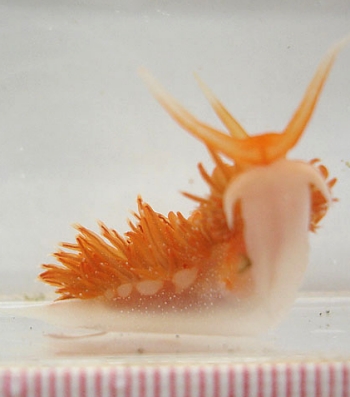
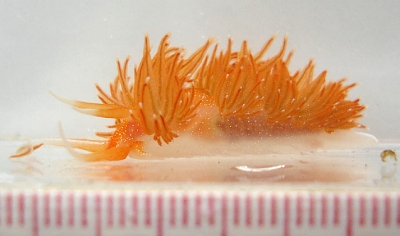
Dear Dr.Rudman,
The right side of this Sakuraeolis enosimensis ahs something attached to it. The photographer said he thought it was the egg mass of S.enosimensis.
I don't think so, but I don't know what is this.
Incidentally, there is nothing on the left side.
Locality: Suma yacht harbor, Kobe, -0.3m, Japan, Pacific ocean, 22 April 2006, Intertidal. Length: 40mm. Photographer: Suma Aqualife Park Volunteers.
Sincerely,
Rie Nakano
rie@divers.ne.jp
Rie Nakano, 2006 (May 3) Sakuraeolis enosimensis - with parasite?. [Message in] Sea Slug Forum. Australian Museum, Sydney. Available from http://www.seaslugforum.net/find/16496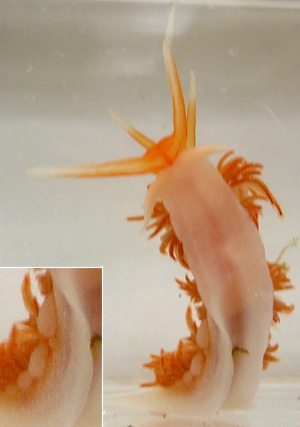
Dear Rie,
It is appropriate we have a question about Sakuraeolis now that its cherry blossom time in Japan as Dr Baba named the genus after the beauty of the cherry trees - sakura.
The swellings on the right side of the body in this species are a total mystery to me. If you look at earlier messages from Japan [#9038, #9150] and Korea [#14633] I have noted their presence before. In those cases it seemed to be associated with mating, but that doesn't seem to be the case with your animal. Yours is also the first time we can see that the swellings are apparently only on the right side of the animal, again suggesting a relationship with the reproductive system. It seems a bit too regular to be a parasitic infection. Usually when nudibranchs have parasites, the swellings are arranged haphazardly, and in different places in each animal.
As I have said before, I haven't seen such swellings in any other aeolid, including other species of Sakuraeolis, so I think this is a mystery that is only going to be solved by someone in Japan or other parts of the NW Pacific where this species occurs.
Best wishes,
Bill Rudman
Sakuraeolis enosimensis mating
February 16, 2006
From: Dong Bum Koh
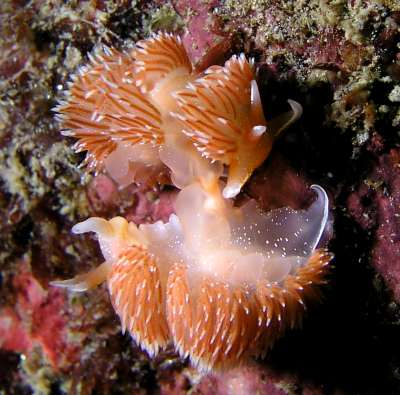
Dear Bill,
Concerning the message of Sakuraeolis enosimensis mating [#9038 ], attached is a photo from Sth Korea showing mating.
Locality: Ul Jin. Kyung Book Province, South Korea, East Sea. Depth: 10 m. Length: Approx. 35 ~ 40mm. 27 May 2005. Photographer: Jung Rae Kim
Best regards,
Dong Bum Koh
drkoh@seasee.co.kr
D. B. Koh, 2006 (Feb 16) Sakuraeolis enosimensis mating. [Message in] Sea Slug Forum. Australian Museum, Sydney. Available from http://www.seaslugforum.net/find/14633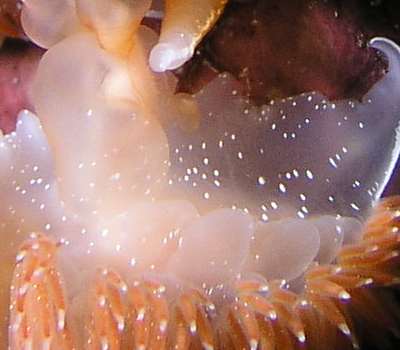
Dear Koh,
This is very interesting because it shows the same strange swellings along the side of the body below the cerata. I have no idea of their function. Perhaps they are something that just happens during mating? Perhaps weak points in the body wall that expand when the body wall contracts to push out the mating apparatus?
Best wishes,
Bill Rudman
Re: Sakuraeolis enosimensis - cannibalistic aeolid?
August 22, 2005
From: XiKun Song
Dear Bill,
Thanks for your quick reply [#14590 ].
The day after I sent the message, I found the carcase had been eaten out, leaving only the red part of the mouth. But your reply makes me think that the carcase was just attached to the predator by sticky mucus by chance.
Thanks!
XiKun Song
Xiamen University,
China, PRC
xksong@yanan.xmu.edu.cn
Song, X. K., 2005 (Aug 22) Re: Sakuraeolis enosimensis - cannibalistic aeolid?. [Message in] Sea Slug Forum. Australian Museum, Sydney. Available from http://www.seaslugforum.net/find/14610Sakuraeolis enosimensis - cannibalistic aeolid?
August 20, 2005
From: XiKun Song
Dear Bill,
Today I found Sakuraeolis enosimensis doing a very interesting thing. I found a larger S. enosimensis (about 2.5cm) eating a smaller one (about 1.5 cm long). All cerata of the prey dropped off, leaving only its white body. With my own eyes, I observed the predator turning over its prey using its head, eating, and eating. Most cerata of the prey were undamaged on the bottom, so maybe the predator doesn't like to eat cerata?
After 4 hours, I found that the larger one carried its prey by using its foot and cerata, to the bottom of the container. So can I guess cerata have a function of carrying left over food?
It's a pity that I didn't have the chance to a photo of this progress.
Thanks!
XiKun Song
Xiamen University,
China
xkosong@yanan.xmu.edu.cn
Song, X. K., 2005 (Aug 20) Sakuraeolis enosimensis - cannibalistic aeolid?. [Message in] Sea Slug Forum. Australian Museum, Sydney. Available from http://www.seaslugforum.net/find/14590Dear Song,
Thanks for this interesting observation. Firstly, quite a few glaucid aeolids are quite aggressive, feeding on a wide range of nudibranchs, including their own species. I think Hermissenda crassicornis is the species whose feeding behaviour has been most studied.
It was interesting to here that the prey animal had dropped all its cerata. As you'll see on the autotomy Fact Sheet, dropping cerata and parts of the mantle, are two well established defence mechanisms in nudibranchs.
I am surprised at the suggestion that the predator carried the apparently dead remains of its prey around the container. I wonder if the carcase was just attached to the predator by sticky mucus. Nudibranchs and many other molluscs, secrete large amounts of sticky mucus when they are badly damaged.
Best wishes,
Bill Rudman
Juvenile Sakuraeolis enosimensis from China
April 23, 2005
From: QinJi
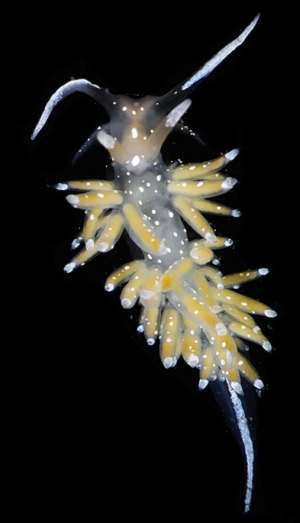
Dear Bill,
I found these very small nudis last sunday in the East China Sea. They would have been about 12-15 mm long. They are found on hydroids. Would I be correct in identifying them as Eubranchidae or Sakuraeolis enosimensis?
Locality: 'fishpond', Xiamen, China. East China Sea. Depth: 2 metres, Length: 10 mm. 17 April 2005. on hydroids. Photographer: QinJi
QinJi
babysmile007@sina.com
QinJi, 2005 (Apr 23) Juvenile Sakuraeolis enosimensis from China. [Message in] Sea Slug Forum. Australian Museum, Sydney. Available from http://www.seaslugforum.net/find/13615This is part of a message from QinJi [#13593] which included 2 species. To allow a cross-reference, I have separated Sakuraeolis enosimensis into this separate message. From the tentacular foot corners, colour pattern and general shape, this certainly appears to be a juvenile of Sakuraeolis enosimensis
Best wishes,
Bill Rudman
Sakuraeolis enosimensis - more photos
February 5, 2003
From: Jun Imamoto
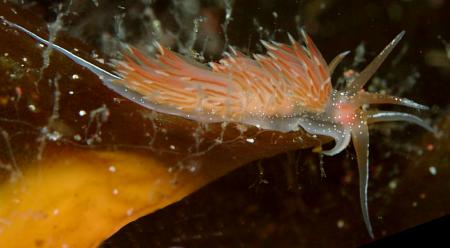
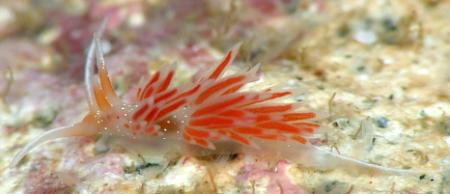
Dear Bill,
To accompany my message concerning the peculiar swellings in the mating Sakuraeolis enosimensis here are photos of 2 more animals. There are no sign of swellings in either of these.
Upper: Osezaki, Suruga Bay, Japan., 11 Mar 2002. Size approx: 20mm., Depth: 5 m, Temp: 19 C. Night dive. Lower: Osezaki, Suruga Bay, Japan., 2 Jan 2003. Size approx: 6mm. Depth: 2 m., Temp: 15 C. Photos: Jun Imamoto
Best Regards,
Jun Imamoto
http://umiushi.zive.net/
imamoto@wips.co.jp
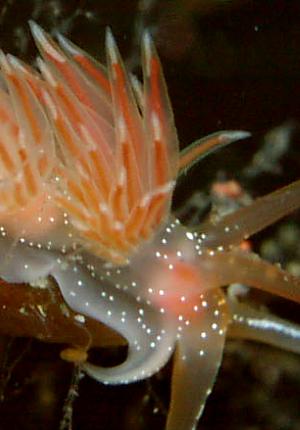
Thanks Jun,
I have included a close-up of the head to show the prominent cnidosacs.
Best wishes,
Bill Rudman
Re: Sakuraeolis enosimensis mating
February 5, 2003
From: Jun Imamoto
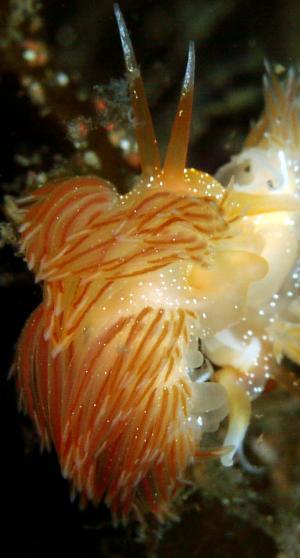
Dear Bill,
Thank you for your comment. I have looked at photos I have of 10 other individuals of Sakuraeolis enosimensis but can't find the strange swellings you asked about in any of them. I have sent photos of two of them in a
separate message.
This is the first time I have seen Sakuraeolis enosimensis mating. It is quite a common animal in Japan so I'll look carefully nexct timne I see them mating. I have enclosed another close-up of the animal with swellings mating.
Osezaki, Suruga Bay, Japan, 11 Mar 2002.,
size approx: 18mm., Depth: 5 m. Night dive. Photo: Jun Imamoto.
Best Regards,
Jun Imamoto
http://umiushi.zive.net/
imamoto@wips.co.jp
Imamoto, J., 2003 (Feb 5) Re: Sakuraeolis enosimensis mating. [Message in] Sea Slug Forum. Australian Museum, Sydney. Available from http://www.seaslugforum.net/find/9150Thanks Jun,
These swellings are quite intriguing. I wonder if any one has noticed then in other aeolids.
Best wishes,
Bill Rudman
Sakuraeolis enosimensis mating
January 31, 2003
From: Jun Imamoto
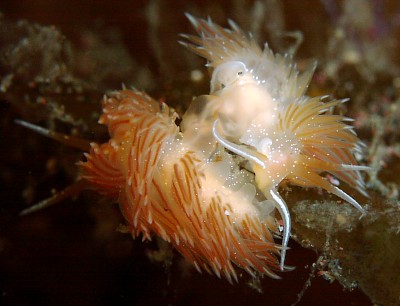
Dear Bill,
To accompany my earlier photos, here is a photo of Sakuraeolis enosimensis, mating.
Osezaki, Suruga Bay, Japan. 11 Mar 2002., Size approx : 18mm., Depth: 5m. Temp: 19C. Night Dive. Photo: Jun Imamoto
Best Regards,
Jun Imamoto
imamoto@wips.co.jp
Imamoto, J., 2003 (Jan 31) Sakuraeolis enosimensis mating. [Message in] Sea Slug Forum. Australian Museum, Sydney. Available from http://www.seaslugforum.net/find/9038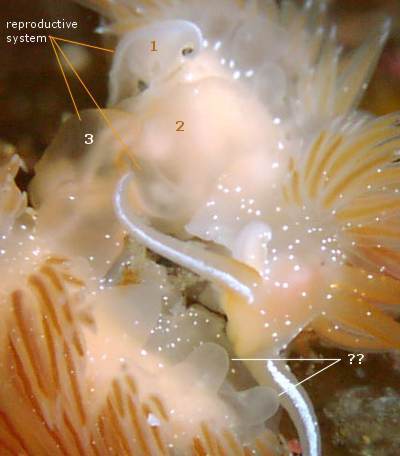
Thanks Jun,
I was preparing a close-up photo to show the copulatory organs more clearly when I noticed the strange swellings I have marked alongside as ??. They seem to be on the side of the body between each clump of cerata. Can you see them on any of your other photos? I have no idea what they are.
But while I have made the close-up here are some details about the reproductive system. Being hermaphrodites, both partner has a penis and a vagina, and usually during copulation both partners exchange sperm. However in this case the animal on the right of the photo is acting only as a female.
1 marks the unused penis of the right animal. One of the anatomical characteristics of the genus Sakuraeolis are the elaborate secondary structures associated with the penis, and although difficult to see here, the flap on the left of the penis is part of these secondary structures.
2 is the vagina, or genital opening of the right animal
3 is the penis of the left animal. It is inserted in its partner's vagina, and the whitish line visible through the wall of the pebnis is the muscular sperm duct.
Best wishes,
Bill Rudman
Sakuraeolis enosimensis from Japan.
January 30, 2003
From: Jun Imamoto
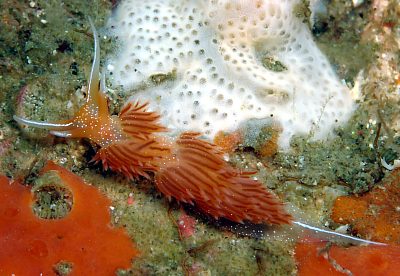
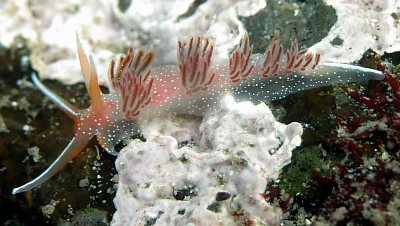
Dear Bill,
Here are some photos of Sakuraeolis enosimensis, which I observed in 2002.
During the day they are usually hidden under rocks but are quite often seen crawling over sea weed-covered rocks at night. They sometimes have a pink parasite on the back.
Upper Image: Osezaki, Suruga Bay, Japan, 30 Apr 2002. Size approx: 20mm., Depth: 10m., Temperature: 19C. Photos: Jun Imamoto
Lower Image:: Osezaki, Suruga Bay, Japan, 18 Mar 2002. Size approx: 18mm., Depth: 1m., Temperature: 20C. Night dive. Photos: Jun Imamoto.
Best Regards,
Jun Imamoto
http://umiushi.zive.net/
imamoto@wips.co.jp
Imamoto, J., 2003 (Jan 30) Sakuraeolis enosimensis from Japan.. [Message in] Sea Slug Forum. Australian Museum, Sydney. Available from http://www.seaslugforum.net/find/9014Thanks Jun,
It's good to get some Japanese photos of this species.
Best wishes,
Bill Rudman
Sakuraeolis enosimensis from Hong Kong
July 20, 2001
From: Leslie Chan
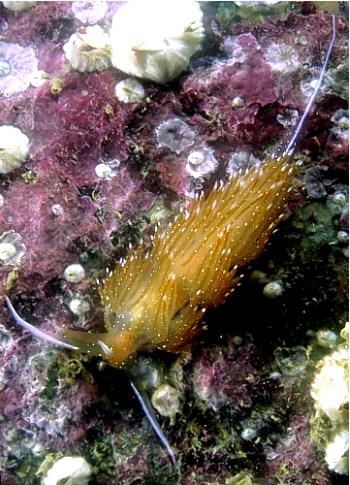
Dear Bill,
Here is another photo of Sakuraeolis enosimensis which I photographed in Hong Kong.
Details: 8m, Trio Island, Hong Kong. 21 January 2001.
Thanks
Leslie Chan
leslie@lesmart.com
Chan, L., 2001 (Jul 20) Sakuraeolis enosimensis from Hong Kong. [Message in] Sea Slug Forum. Australian Museum, Sydney. Available from http://www.seaslugforum.net/find/4771Thanks Leslie,
Best wishes,
Bill Rudman
Sakuraeolis enosimensis in San Francisco
July 18, 2001
From: Dave Behrens
Hi Bill:
Just a note to point out that Sakuraeolis enosimensis was introduced to San Fransisco Bay some time ago (Behrens 1982)and has become very established. On the average it may be the second most common opisthobranch species in the bay today.
• Behrens,D.W. (1982) Sakuraeolis enosimensis (Baba, 1930) (Nudibranchia: Aeolidacea) in San Francisco Bay. The Veliger, 24(4): 359-363.
Dave
dave@seachallengers.com
Behrens, D., 2001 (Jul 18) Sakuraeolis enosimensis in San Francisco. [Message in] Sea Slug Forum. Australian Museum, Sydney. Available from http://www.seaslugforum.net/find/4832Thanks Dave,
Bill Rudman.
Re: Sakuraeolis enosimensis from Hong Kong
July 16, 2001
From: Kathe R. Jensen
Dear Bill,
This is not really the first record from Hong Kong. Sakuraeolis enosimensis was listed in the book on Sea Shore Ecology of Hong Kong (see below). In this book there is a colour picture of a bright red animal (Plate 27), but still with the white spots. And I think it is also this species figured in John Orr's little book (see below) on p. 73 and identified as Coryphella sp.. I also listed the species in my zoogeographic review (see below) as one of the many species with a Japan + Hong Kong distribution.
References:
• Morton, B. & Morton, J. 1983, The Sea Shore Ecology of Hong Kong. Hong Kong University Press, 350pp.
• Orr, J. 1981. Hong Kong Nudibranchs. The Urban Council Hong Kong, 82pp.
• Jensen, K.R. 1998. Zoogeographic affinities of Hong Kong Opisthobranchia (Mollusca, Gastropoda). Pp. 43-55 in: The Marine Biology of the South China Sea (ed. B. Morton). Hong Kong University Press.
Greetings,
Kathe
jensen@ait.ac.th
Jensen, K.R., 2001 (Jul 16) Re: Sakuraeolis enosimensis from Hong Kong. [Message in] Sea Slug Forum. Australian Museum, Sydney. Available from http://www.seaslugforum.net/find/4829Thanks Kathe,
By coincidence I was talking to Brian Morton a few minutes ago. He is a on a quick visit 'down under'. As you say, the painting in Morton & Morton is probably this species, and the photo on John Orr's book definitely is.
Cheers,
Bill Rudman
Sakuraeolis enosimensis from Hong Kong
July 15, 2001
From: Leslie Chan

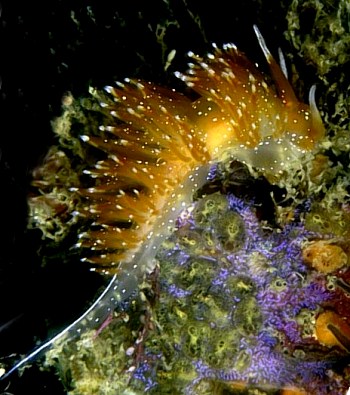
Dear Bill,
Could you identify this nudibranch which I photographed in Hong Kong.
Details: 12m, Ninepin Group, Hong Kong. 21 January 2001.
Thanks
Leslie Chan
leslie@lesmart.com
Chan, L., 2001 (Jul 15) Sakuraeolis enosimensis from Hong Kong. [Message in] Sea Slug Forum. Australian Museum, Sydney. Available from http://www.seaslugforum.net/find/4776Dear Leslie,
This is Sakuraeolis enosimensis. A new record from Hong Kong. Thanks for the photos.
Best wishes,
Bill Rudman
